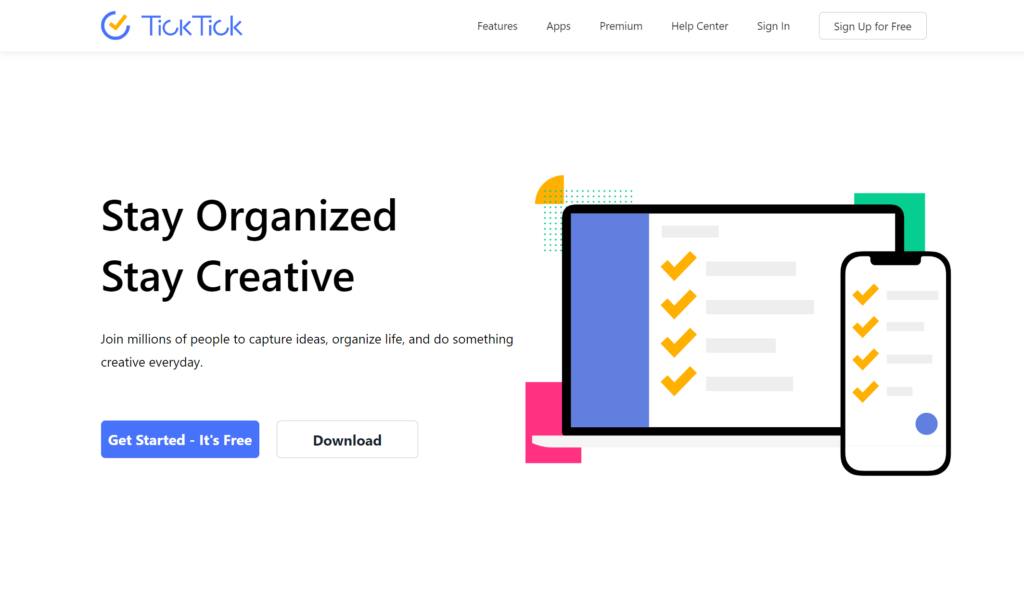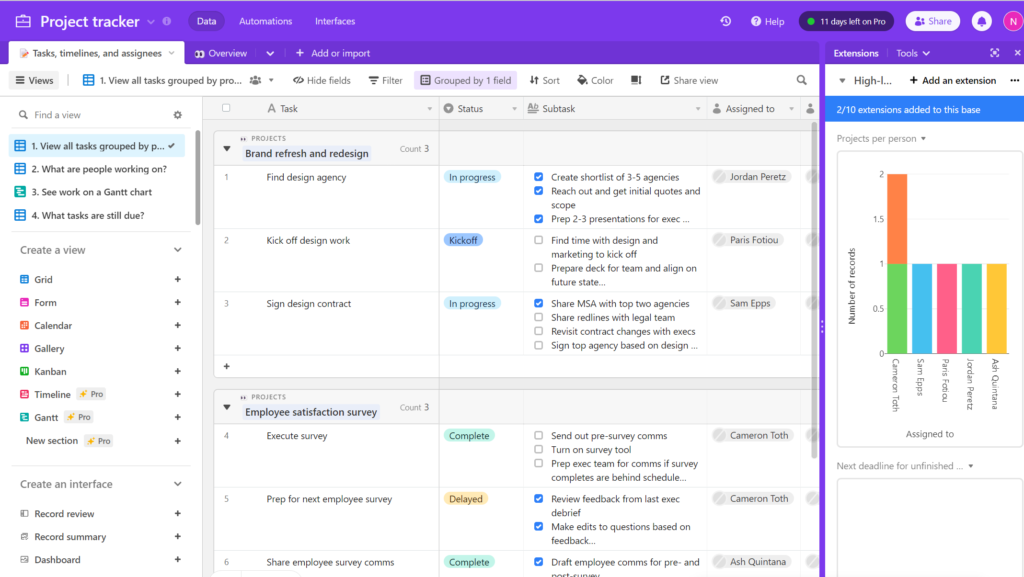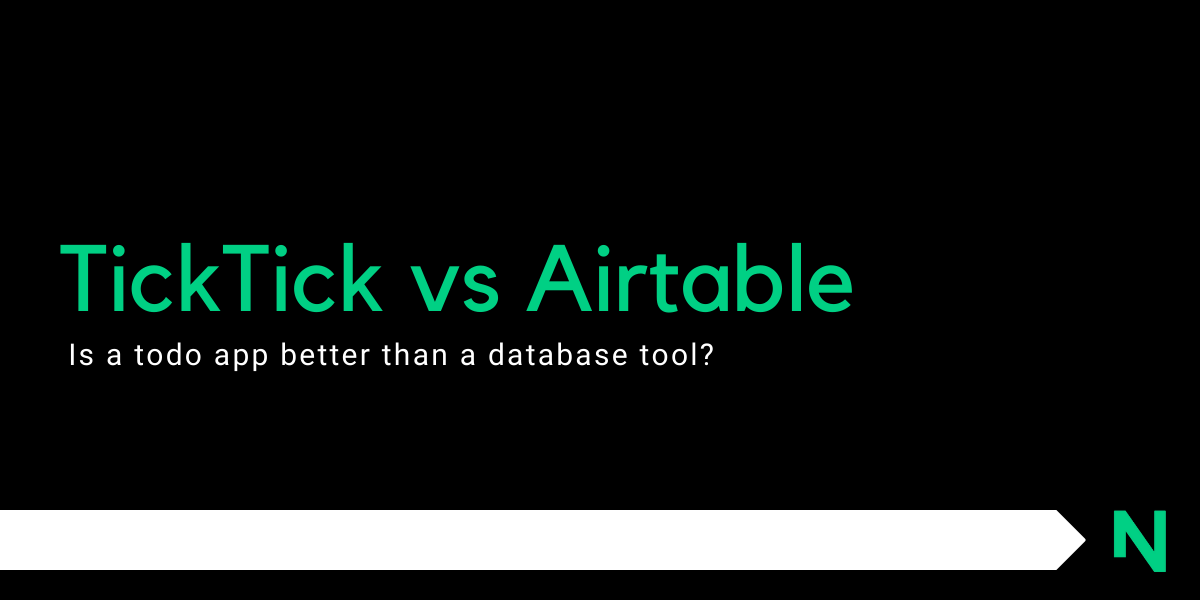Make sure your projects stay on track with TickTick and Airtable! These apps are great for managing tasks, tracking progress, and keeping everything organized. But which one is the best fit for your needs? In this comparison, we’ll break down the features of both TickTick and Airtable and help you decide which one is right for you.
TickTick vs Airtable – A Detailed Comparison
Let’s get right into the comparison of TickTick and Airtable’s features, pros and cons, and pricing and reviews.
What is TickTick?

TickTick is a free task management and to-do list tool that focuses on productivity and simplicity. It assists you in staying organized, managing your time, and achieving your goals.
The app has a simple and user-friendly layout, with a list of to-dos and activities that can be sorted by date, priority, and category. It also has features like reminders, notes, collaboration tools, and much more. TickTick is an iOS, Android, Mac, Windows, and online app.
What is Airtable?

Airtable is a game-changing collaboration and organization platform that is transforming the way people work.
With its unique blend of a database, spreadsheet, and document editor features, Airtable makes it easy to create and manage data in a flexible and customizable way.
Whether you’re a project manager looking to keep track of your team’s progress, a marketing team looking to organize your assets, or a small business owner looking to streamline your operations, Airtable has you covered.
With its user-friendly interface and powerful integrations, you can get up and running quickly and easily, and start collaborating and organizing like never before.
TickTick vs Airtable Features
Features of TickTick
- Voice input: Allows users to add tasks fast and easily by speaking into their smartphone.
- Smart date parsing: While creating a new task, it automatically parses the due date and time information and sets a reminder.
- Users can schedule recurring tasks to repeat on a regular basis.
- Folders, lists, and tags: Offer various degrees of organizability to assist users in keeping their tasks and goals clear and manageable.
- Many reminders: To avoid missing a deadline, users can create multiple reminders for a task or utilize the “Annoying Alert” option.
- Pomodoro timer: assists users in practicing the Pomodoro Technique, which divides work into focused intervals interrupted by brief pauses.
- Calendar views: provides customers with a variety of calendar views, ranging from daily to monthly, to assist them to see their projects and deadlines at a glance.
- Sharing and collaboration allow users to share their lists and tasks with others and collaborate to complete tasks.
- Synchronization guarantees that users can access their tasks and updates from any device and that their data is up to date across all platforms.
Features of Airtable
- Flexible and customizable data organization: Airtable allows users to create and organize their data in a way that makes sense for their specific needs, using a variety of field types and views (e.g. grids, calendars, galleries) to display and manipulate the data.
- Collaboration and sharing: Airtable makes it easy for teams to collaborate and share information in real-time, with features such as commenting, tagging, and @mentions to facilitate communication and coordination.
- Integration with other tools: Airtable integrates with a wide range of other tools and platforms, including popular productivity and project management apps such as Trello, Slack, and Google Drive. This allows users to seamlessly incorporate their Airtable data into their existing workflows.
- Robust API and automation capabilities: Airtable offers a powerful API and support for integrations with popular automation tools such as Zapier and IFTTT, enabling users to automate repetitive tasks and create custom workflows.
- Security and reliability: Airtable is built on top of a secure, scalable infrastructure and offers a range of security controls and features to protect user data, including encryption, access controls, and backup and recovery options.
TickTick vs Airtable Pros and Cons
TickTick Pros and Cons
Sure, here is an expanded list of pros and cons of TickTick with more details and user reviews:
Pros:
- It has a free version available with basic features. This allows users to try out the app before committing to a premium plan. According to a user review, “I like that there is a free version that still has a lot of functionality.”1
- It has a built-in Pomodoro timer and a calendar view that helps users focus and plan their tasks. These features are useful for managing time and productivity. A user review we found online said, “I love the Pomodoro feature and the calendar view. It helps me stay focused and organized.”
- It has a cheaper premium plan than some of its competitors, such as Todoist, with almost equal functionality. This makes it more affordable for users who need more advanced features. As per a user, “TickTick is cheaper than Todoist and has almost the same features. I think it’s a great value for money.”
- It has a simple and effective interface that is similar to Todoist. This makes it easy to use and familiar for users who have used Todoist before. A TickTick user said, “TickTick is very similar to Todoist in terms of interface and functionality. I find it very easy to use and intuitive.”
Cons:
- The free version has too many restrictions, such as limited number of lists, tasks, reminders, subtasks, etc. This limits the usability and functionality of the app for users who have more complex needs. A TickTick user said, “The free version is too restrictive for me. I need more lists, tasks, reminders, subtasks, etc. I don’t want to pay for the premium plan just to get these features.”
- Some features are hard to find or do not work as expected, such as smart lists, natural language processing, or recurring tasks. This makes it frustrating and confusing for users who want to use these features. A reviewer mentioned, “Some features are hidden or not working properly. For example, I can’t figure out how to use smart lists or natural language processing. And sometimes recurring tasks do not repeat correctly.”
- It does not have some advanced features that other apps offer, such as location-based reminders, project templates, or integrations with other apps. This makes it less versatile and compatible for users who need these features. According to a user review, “TickTick does not have some features that I need, such as location-based reminders, project templates, or integrations with other apps. I wish it had more options and flexibility.”
Pros and Cons of Airtable
Pros of Airtable
- Airtable is incredibly versatile and allows users to create ready-made or customizable apps with minimal setup time or personnel training.
- Real-time data accessibility allows users to collaborate with other teams on shared data and view the most up-to-date information to make accurate decisions.
- The intuitive app builder and ready-made work views enable users to quickly create the tools they need and view data in different ways to find relevant insight.
- Built-in automation and integration with more than two dozen apps allow users to streamline manual processes and increase their efficiency.
Cons of Airtable
- Airtable lacks the depth of features and functions that dedicated project management software offers.
- Collaboration between bases is segmented, and creating a synced table or copying data to a new table requires complex steps.
- The graph/chart apps are great but are not significantly customizable, and extensions are limited on the lowest-priced paid plan.
TickTick vs Airtable Pricing
TickTick Pricing
TickTick offers an annual premium plan for $27.99, which works out to be less than $2.4 per month.
Airtable pricing
Airtable has four pricing plans:
- Free: Designed for individuals or small teams just starting out with Airtable, and is offered at no cost. It includes unlimited bases, up to 5 creators or editors, unlimited commenter and read-only users, and a limited number of records and attachments per base.
- Plus plan: Priced at $10 per seat per month when billed annually, or $12 when billed monthly. Intended for teams looking to create connected apps to manage their workflows. It includes additional features such as custom branded forms and automatic table syncing.
- Pro plan: Costs $20 per seat per month when billed annually, or $24 when billed monthly. Designed for teams and departments who need to build connected apps to power their most important processes. It includes features such as Gantt and Timeline Views and granular interface permissions.
- Enterprise plan: Geared towards departments and organizations who need a scalable and customizable connected apps platform, and is priced through custom quotes. It includes advanced features such as SAML-based single sign-on and an enterprise-wide admin panel.
TickTick vs Airtable Review
TickTick Review
Love this app! Even the free version is amazing! It helps me organize both my personal and work life as a business owner. I’ve gone through many different apps and software and TickTick is definitely the best fit for me.
A user review from the app store
- TickTick has a 4.7 rating on the Android app store. Its user base is largely satisfied with the app features and the user interface. Read all reviews here.
- On the Apple app store, TickTick has a whopping 4.9 rating making it one of the highest-rated productivity apps out there. Read all reviews here.
Airtable reviews
- Airtable is rated 4.6 out of 5 stars by 2000+ people on G2. Read reviews here.
- It also has a 4.7 of 5 rating on Trustradius. You can read the reviews here.
